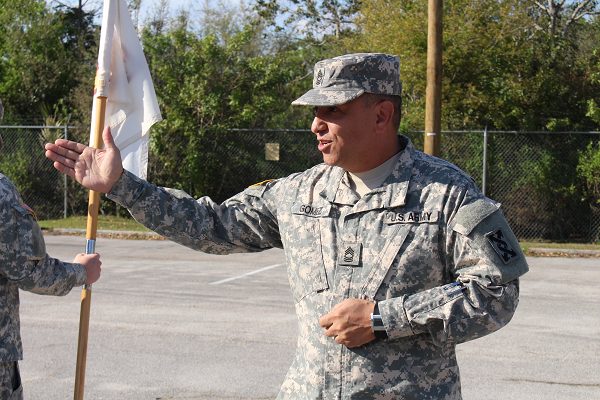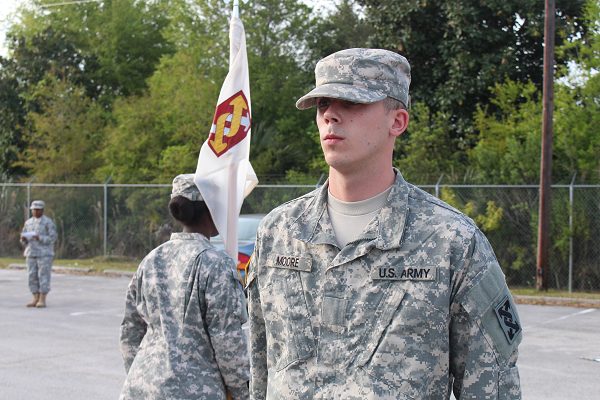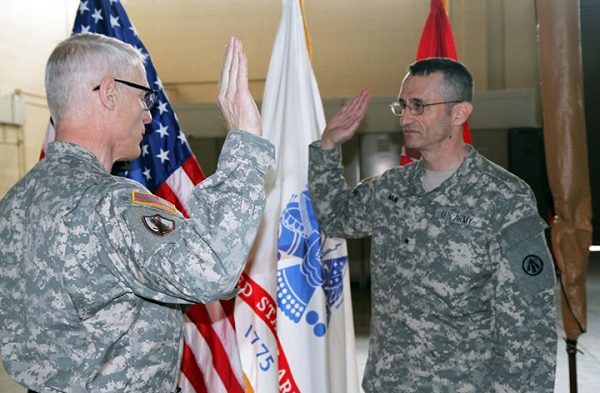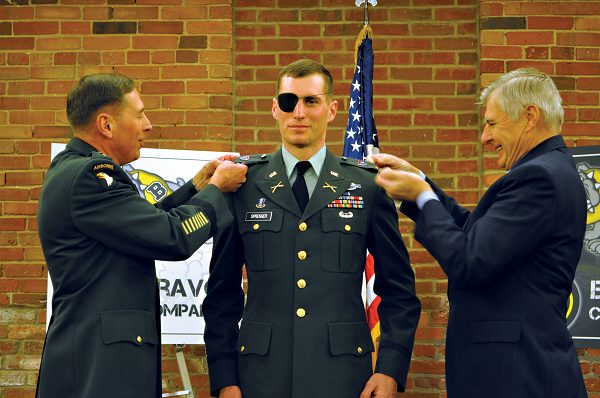When considering your career in the Army, it is vital to consider the Army promotion timeline when you plan.
The Army consists of 13 different enlisted ranks. These ranks break into Junior enlisted, Noncommissioned officers, and Senior Noncommissioned officers.
Also, the Army has commissioned officers.
The Army bases some of its promotion criteria on time in service and time in pay grade.
However, the higher up the promotion rank, the more competitive promotions become.
Army Promotion Timeline for Junior Enlisted Ranks

An E-1 is the lowest rank in the Army. E-1 is the initial rank for those just coming out of basic training.
Also, to promote to an E-2, which is a private second-class (PV2), you need six months of service or four months of service with advanced college or ROTC.
Afterward, promotion to an E-3, or private first class (PFC), happens after 12 months of enlistment and at least four months as an E-2.
Lastly, to continue to a Specialist (E-4), you will need two years of service and at least six months of time in pay grade.
Related Article – What Happens After Army Boot Camp?
Army Promotion Timeline for NCO Ranks

There are three levels of Noncommissioned officers in the Army.
Corporal (E-4)
The lowest noncommissioned officer rank is a Corporal.
Also, you might notice that the E-4 designation for the Corporal is the same as the Specialist in the Junior Enlisted ranks.
However, even though these two have the same pay rank, they have different responsibilities.
A Specialist is known for having technical experience and knowledge.
However, a Corporal, despite being the lowest rank possible for a noncommissioned officer, is more about leadership.
Your unit commander can promote you to Corporal if you have 26 months in service, along with six months of time in grade (three with a waiver).
You also need a security clearance that matches your MOS.
Sergeant (E-5)
Advancement to a Sergeant is competitive in the Army.
Specialist E-4s must first be promoted to Corporal E-4 before becoming eligible for the rank of Sergeant.
To make Corporal, Specialists must complete Basic Leader Course (BLC) and be recommended for advancement by a promotion board.
Corporals hoping for a promotion to E-5 must meet the following expectations:
- Civilian education level
- Completion of the Primary Leadership Development Course
- Eight months of time in grade
- 36 months of time in service
- Unit commander recommendation
Staff Sergeant (E-6)
A Staff Sergeant works closely with other sergeants on the development of soldiers in their section.
Candidates for Staff Sergeant must be meet the following requirements to be eligible for promotion:
- Civilian education level
- Completion of the Primary Leadership Development Course
- 10 months of time in grade
- 84 months of time in service
- Unit commander recommendation
Army Promotion Timeline for Senior NCO

Senior noncommissioned officers have a higher level of responsibility.
There are only three pay grades in this set of ranks.
- Sergeant First Class (E-7)
- Master Sergeant (E-8)
- First Sergeant (E-8)
Master Sergeant and First Sergeant share the grade of E-8, but they have different roles and responsibilities in the Army.
The Army changed how it promotes Senior NCOs recently.
With the new system, Staff Sergeants now have a minimum Time in Grade (TIG) requirement, as well as a Time in Service (TIS) requirement.
Depending on their MOS, E-6 sergeants must spend from 36 to 48 months in grade before being considered for promotion to E-7, Sergeant First Class.
They almost must have a minimum of 8 years of time in service.
Promotions for E-8 through E-9 are dependent on command-level assessments that factor in leadership skills, communications abilities, feedback from peers and subordinations, psychological evaluations, and physical fitness.
For promotion from E-7 to E-8, the soldier must have completed 36 months of TIG and 12 years TIS.
Those working toward a promotion to E-9 must have completed 36 months of TIG and 16 years of TIS.
For all senior NCO grades, candidates need to meet leadership education goals established by Army Regulation 350-1.
As of FY 2023, however, backlogs in leadership training have meant that the Army is offering temporary promotions pending the completion of required training.
Related Article – H&M Military Discount
Army Promotion Timeline for Commissioned Officer
Enlisted soldiers and college graduates, as well as those identified as commission candidates, must complete Officer Candidate School (OCS) before receiving a commission.
Promotions for U.S. Army commissioned officers are determined by promotion selection boards once the candidate has completed the required time in grade (TIG).
Second Lieutenant (O-1)
Most soldiers start their officer career as a second lieutenant after completing the requirements mentioned above.
First Lieutenant (O-2)
For promotion to First Lieutenant, you need 18 months of time in grade to be eligible for consideration by the promotion selection board.
Captain (O-3)
First Lieutenants require a minimum of two years of TIG to be considered for promotion to Captain.
Major (O-4)
Becoming a Major requires a minimum of 3 years as a Captain to be in the zone for consideration for promotion.
However, the TIG requirement may be waived as part of the Below the Zone (BZ) recommendation system for the ranks of Major, Lt. Col, and Col. These early promotions generally number below 10% of the total promotions authorized.
Lieutenant Colonel (O-5)
To become a Lieutenant Colonel, you need at least three years of time in grade for consideration by the selection board.
Also, prepare for competition for this rank.
Colonel (O-6)
The rank of Colonel also requires at least three years of time in grade before eligible by the promotion selection board, unless recommended for BZ.
Related Article – 15 Series MOS: US Army Aviation Jobs
Army Promotion Timeline for Brigadier General and Above
There are four more grades to consider in your Army career.
First, for consideration for promotion to the rank of Brigadier General, you’ll need at least one year as a Colonel to be eligible for the selection board.
Also, in all four of these cases, you will need to complete a full tour of joint duty with the Air Force, Marines, Navy, or Coast Guard.
- Brigadier General (O-7)
- Major General (O-8)
- Lieutenant General (O-9)
- General (O-10)
Army Promotion Timeline FAQ
There are likely additional questions as you plan for your career according to the Army promotion timeline.
Are There Opportunities for Accelerated Advancement?
For those who enter the Army, you might be eligible to enter with advanced rank. There is more than one path to earning this advanced rank.
Check with your recruiter, but if you participate in the following, you may find yourself leaving basic training as a private first class.
- At least three years of Junior ROTC
- A year of senior reserve officer training
- At least two years of VOTEC (vocational-technical) training
- 48 college credits at an accredited school
How Does the Point System Work?
The administrative points that help determine promotions include awards, decorations, both military and civilian education, and duty performance.
The duty performance points are awards from the unit commander.
Also, senior leadership makes recommendations to the unit commander.
Responsibility and Accountability
A soldier needs to demonstrate they are trustworthy and dependable.
Training
Knowledge and experience are essential in a soldier’s career. Also, they must demonstrate they can guide and teach others.
Leadership
Soldiers up for promotion must demonstrate they possess the ability to guide and motivate others.
Military Bearing
Promotable soldiers should carry themselves in a manner that shows confidence and attention to detail in how they dress in uniform.
Competence
A soldier ready for promotion should show proficiency in their area of expertise and can effectively communicate.
What Does the Promotion Board Consider?
The promotion board meets with soldiers and scores them based on personal appearance, the ability to communicate well, knowledge and awareness of both the military and world events, as well as their attitude.
Also, the members rate the soldiers as average, above average, excellent, and outstanding.
The most points a board member can give is 150, which are added up and divided into an average score.
Afterward, these points add to the administrative points discussed above.
Therefore, the highest total is 850 points.
Conclusion
In the Army, the early ranks are more automatic.
Also, as you move along in rank and invest in your Army career, the subsequent ranks become more competitive.
Furthermore, soldiers have access to a mentor to help with planning and provide counseling on earning points based on education levels and other meritorious actions.
References:
- Ikon Pass Military Discount: Learn How To Save Big - January 31, 2025
- RTIC Military Discount: Find Out How To Save Big on Gear - January 30, 2025
- Traeger Military Discount: Learn How To Save Big on Smokers - January 28, 2025





